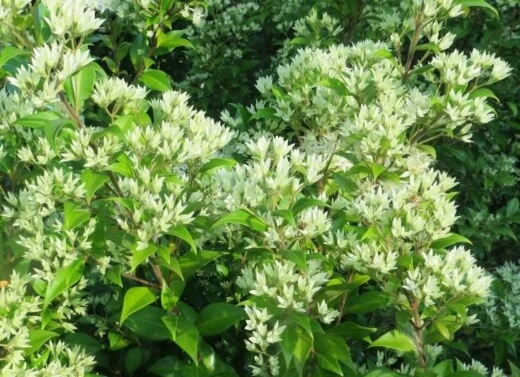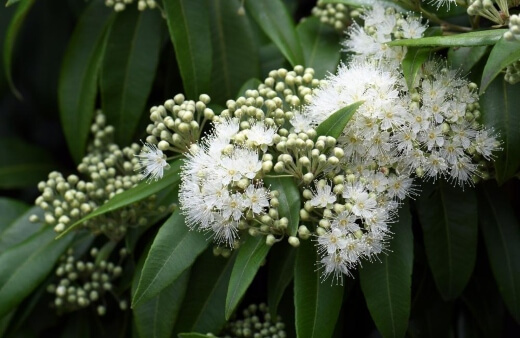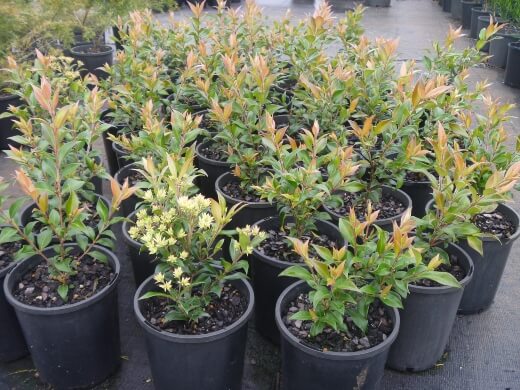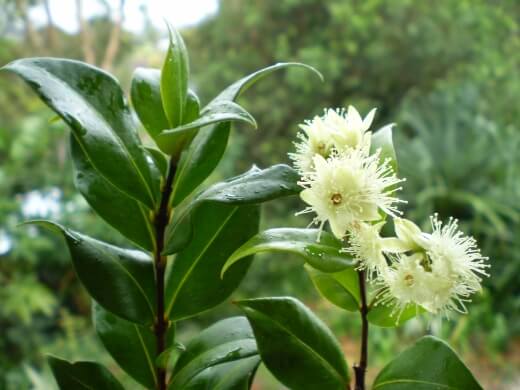The cinnamon myrtle might seem like a humble rainforest tree, but it’s created a booming export business thanks to its flowers, earning itself a name on the world’s stage.
In our how to grow and care guide, we’ll look at what your cinnamon myrtle needs to thrive in terms of light, soil and fertiliser, we’ll go through any pests and diseases to look out for, how to propagate this tree, and some frequently asked questions.
More...
Genus: | Backhousia |
|---|---|
Species: | B. myrtifolia |
Family: | Myrtaceae |
Common Names: | Cinnamon myrtle |
Plant type: | Evergreen tree or shrub |
Sunlight: | Full-sun and part-shade |
Height: | 3-7m |
Width: | 3-4m |
Water: | Tolerates drought |
Soil: | Sandy, mildly acidic to mildly alkaline |
Maintenance level: | Medium |
Poisonous to pets: | No |
Introducing Cinnamon Myrtle

Source: myrainforest.wordpress.com
Backhousia myrtifolia is found in the rainforests of subtropical Australia, all the way from Bega on the NSW south coast, to Fraser Island off Queensland. It is a small tree, growing to about 7 metres.
Cinnamon myrtle as it is more commonly known, grows well in most soils and climates. It can handle long, dry summers if it gets regular water. The cinnamon myrtle tree grows best in full sun, but can also grow happily under part-shade or full shade.
The leaves of Backhousia myrtifolia start out light and bright green when they are young and become darker with age. The flowers are star-shaped. In the wild, this plant can reach heights of up to 7 metres.
In a home garden, you’re looking at about a 3 metre height. The tree has naturally dense foliage which makes it an excellent shade tree. It also works well as a screen or windbreak and you can keep it smaller with regular pruning.
Backhousia myrtifolia is often called iron wood and grey myrtle in addition to cinnamon myrtle. The rainforest tree species was first discovered and used by the indigenous communities of Australia, especially because the plant produces oils that have a cinnamon-like aroma, and have antibacterial and antifungal properties.
This plant is known for the snow-white colour of its flowers – this has made it popular as both a domestic tree but is also an internationally exported product.
How to Grow and Care for Grey Myrtle

Sunlight Requirements
Your cinnamon myrtle plant will need full to partial sun in a west or south-facing spot that is sheltered from the cold and dry wind. If you are growing this plant as a bonsai indoors, the tree will need lots of light and air.
Place it in semi-shade outside in the heat of summer and in autumn, you can bring your tree inside to a cool room and put it on a south-facing windowsill.
Best Soil for Grey Myrtle
This plant needs moist but well-drained soil. It can adapt to clay or sand as well, just aim for high-quality premium soil or a premium potting mix if placing it in a pot.
Be careful of iron chlorosis in highly alkaline soil that has a pH higher than 8.3. You can lower the soil pH with elemental sulphur or nitrogen fertiliser. Adding soil conditioner when planting enhances settling in of the tree and root development.
Watering Schedule
It’s preferable to plant Backhousia myrtifolia in autumn for optimum root development and new growth in spring. You can also plant in spring but will need to water it all summer long during the first year after you’ve planted.


Get Your Free Guide:
Master Growing Australian Natives eBook
A Must Have Complete Guide for Every Australian Garden
Get Your Free Guide:
Master Growing Australian Natives eBook
A Must Have Complete Guide for Every Australian Garden
The young cinnamon myrtle plant needs sufficient water for the first 6-8 weeks. Water the root ball once a week or more when the plant is young.
Don’t soak it as this can also cause possible iron chlorosis. An older plant does well with a deeper watering every two to four weeks. It can also do well without water for short periods.
Just a little tip, this plant doesn’t do well with high concentrations of lime which can be found in tap water. If you can harvest rainwater that would be ideal.
Fertilising Cinnamon Myrtle
Avoid excessive use of manure and fertiliser. As a guideline for outdoor growing, you can fertilise once a year in early spring. For indoors, use a native liquid fertiliser weekly during the growing season.
Watch your cinnamon myrtle in the winter because if it's growing even a little bit, you may need to fertilise it every two weeks.
Backhousia myrtifolia Propagation

Source: nativesrus.com.au
Propagation of Backhousia myrtifolia can easily be achieved by taking a cutting from an established cinnamon myrtle tree. Begin by cutting a stem off the main bush of a healthy tree, just below a leaf node that's on a branch with new growth.
Longer cuttings develop a more extensive root system, so aim for a cutting that's about 15 centimetres. The best time to take a cutting is in the spring when there's visible new growth.
Strip the leaves off the bottom half of the cutting. By removing the lower leaves, you encourage root and leaf growth and it helps the tree to establish itself easily. Dip the end of the cutting in a rooting hormone.
A cutting will grow roots on its own, but a rooting hormone will help speed up the process. Choose a spot for your cinnamon myrtle tree that's partially shaded. This plant likes to be protected from the full sun when it’s young.
If you live in a mild climate, the plant will tolerate full sun. You can add rocks and organic material to the soil if there is poor soil drainage as cinnamon myrtles do not like to be waterlogged.
If your garden is generally filled with standing water, try adding a mixture of small rocks, wood chips, compost, and sand in a 15 cm layer to increase soil drainage.
Use a stick to make a hole in the ground and place the cutting in the hole. If you push the cutting into the ground, you might damage it. Once the cutting is in the hole, you can press the soil down around the cutting tightly.
You can plant your cutting in a pot or directly into the garden. A pot means you’ll be able to bring your cutting inside as it grows into an established cinnamon myrtle tree and you can then transplant it into your garden once it outgrows the pot.
For more on taking cuttings, refer to our guide on the types of cuttings and how to properly take them.
Cinnamon Myrtle Bush Tucker Guide

Source: temperate.theferns.info
Cinnamon myrtle became popular as a bush food in the late 1980s. The leaves give off a cinnamon fragrance when you rub or crush them, similar to the leaves of the curry plant and kaffir lime. (Learn how to grow and care for kaffir lime here.)
Cinnamon myrtle leaves can be used in place of conventional cinnamon spice to flavour curries, stews, soups, roasts, ribs and sauces. They are wonderful in steamed rice.
You can use them in desserts to add a warm, earthy flavour for delicious eats like pies, biscuits, sweets, pastries and slices. The gentle aromatic profile has undernotes of pepper and paprika.
It is delicious in mulled wine and is a wonderful addition to traditional sangria recipes. The leaves may also be used fresh or dried to make a herbal tea. Just add hot water. This calming medicinal tea is useful for dyspepsia, heartburn, colic and digestive issues.
Harvesting Cinnamon Myrtle
To harvest your cinnamon myrtle, choose young, soft leaves and pluck them straight off the branch. If you choose to buy, you’ll find it as a whole leaf spice, dried and ground, and ready to use.
Backhousia myrtifolia is rich in fibre, vitamins (Vitamin A, C, E, K and pyridoxine) and minerals (potassium, calcium and copper) which are important for healthy body function.
These vitamins function as coenzymes in the body and minerals like potassium maintain musculoskeletal function. The main essential oil in cinnamon myrtle is elemicin, which is also a significant flavour component in nutmeg.
Once you discover the joy of bush tucker, you might be inspired by a whole new culinary world. Have a look at our other bush tucker articles for more plants to choose from.
Common Backhousia myrtifolia Pests and Diseases
This plant can be affected by post-harvest browning syndrome. This is a disease that causes leaf discolouration and wilting.

Source: en.wikipedia.org
Myrtle rust
The other culprit to look out for is myrtle rust. The fungus responsible for myrtle rust (Austropuccinia psidii) can produce many airborne and sticky spores. Myrtle rust attacks the young, soft, and actively growing leaves, shoot tips, stems, fruits and flowers of Backhousia myrtifolia.
The first sign of myrtle rust is probably yellow or white spots on the leaves and shoots, which are followed by a huge amount of egg-yolk yellow coloured spores.
This is usually about 14 days after infection. It starts on the underside of the leaf and then moves to the upper leaf surface. Lesions on the leaf turn red-purple and then brown.
Sometimes they are surrounded by a purple margin. Old lesions are usually grey and can still contain a few spores.
Myrtle rust treatment
Spray infected plants with a fungicide three to four days before removal. If you aren’t able to treat with fungicide, carefully wet the plants before removing them to dampen any spores that might shift during removal.
If a small plant is affected, you can apply hairspray to stick down the spores onto the affected plant. When it comes to plant removal, small plants can be closed in a plastic bag before you pull or dig them out.
For potted plants, the whole plant, plus the pot, should be placed into the bag and sealed. For larger plants that don’t fit in the bin, they can be cut into smaller pieces and securely covered with black plastic bags or something similar.
Place the bags in a sunny spot for three to four weeks to kill spores, especially if the plants were not treated with fungicide.
Need some tools and products to get the job done? We have in-depth reviews and buying guides about everything from garden hoses to pruning saws.
Backhousia myrtifolia Frequently Asked Questions

Source: apps.lucidcentral.org
How much water does a cinnamon myrtle need?
In warmer climates, you can mulch around the base in late spring and water your tree heavily once a week. Water every few days if your cinnamon myrtle tree is in a pot.
Check out our guide on the best types of mulches you can use for your garden and learn when to use them.
What are the round lumps on my cinnamon myrtle leaves and branches?
This is most likely a scale infestation but it won’t kill your plant. Scale can be controlled with white oil, and you can follow the instructions on the bottle.
Will a cinnamon myrtle grow well in cold weather?
Cinnamon myrtle will tolerate the cold, but it does need protection from frost when the plant is young. If the plant is in a pot, you can move it to a warm north facing wall.
What are some of the uses of cinnamon myrtle?
The antiseptic properties of cinnamon myrtle's oils make it a great insect repellent against mosquitoes, flies and beetles. Elemicin, a compound from the oils of cinnamon myrtle leaves, can replace an ingredient like citronella oil, which is the common active ingredient in candle and torch insect repellents.
Cinnamon myrtle as an application with anti-bacterial and antifungal properties, has been used to treat urinary tract infections, rheumatoid arthritis and gastro-intestinal infections.
Since Backhousia myrtifolia plants are non-toxic, they are suitable as an internal or topical treatment for bacterial/fungal infections. This plant produces essential oils which are further added to moisturisers and other skin products.
The wood is very tough and was used for tool handles and mallets by early settlers and was used in similar fashion by Aboriginal people for various implements.
Is cinnamon myrtle used for export?
Cinnamon myrtle is a popular product for international export, especially to Asia (Japan in particular). The reason for its popularity is the unique ivory-white colour of its flowers.
In the period 1995 to 2000 export profits for cinnamon myrtle were incredibly high, especially around the holiday season. The flower was labelled “the Christmas Carol” by Australian farmers.
Backhousia myrtifolia was exported for its beauty rather than medicinal or food-related uses. Australians in southern NSW began to develop farms dedicated to production of cinnamon myrtle.
What were the Aboriginal and traditional uses of cinnamon myrtle?
Myrtaceae makes up 60% of Australian forest species. The powerful flavour was harvested by both indigenous peoples and later by colonists. The nutrient filled leaves were crushed and applied topically, and added to cooking for people living in the region.
Keen on growing more Australian native plants? Check out our in-depth guide on how to grow NSW Christmas bush to add more colour to your garden.

Wrapping Up Our Cinnamon Myrtle Growing and Care Guide
If your garden is in need of a lovely rainforest tree that produces an abundance of blooms and smells good, cinnamon myrtle makes a great choice. You can harvest the leaves to make a cleansing tee, or be inspired to bake and add a pinch of earth flavour.
The Backhousia myrtifolia doesn’t struggle much with pests and disease, and because it can grow in light from full sun to part shade, it’s versatile in terms of placement.
The indigenous people were onto something when they used the cinnamon myrtle leaves for flavour and for their first aid kit. What a spectacular creation! We’re giving the cinnamon myrtle our green thumbs up!
Published on July 4, 2022 by Nathan Schwartz
Last Updated on January 21, 2025




